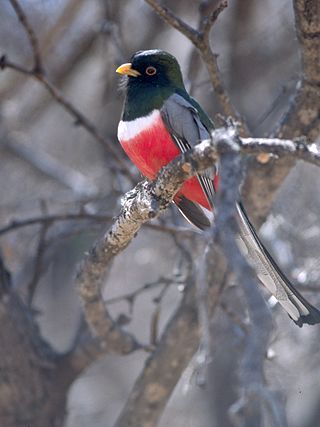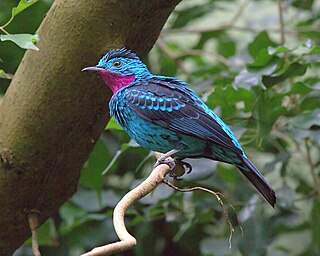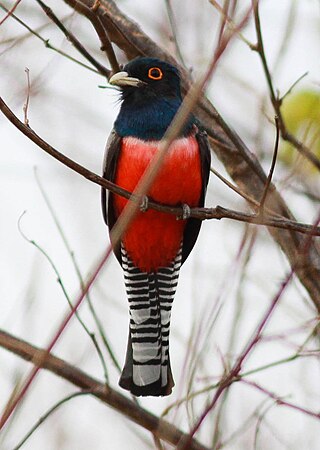
The garden sunbird, previously known as the olive-backed sunbird, is a species of passerine bird in the family Nectariniidae that is found in the Philippines except on the Palawan island group. It was formerly considered to be conspecific with seven other species: the ornate sunbird, Palawan sunbird, Sahul sunbird, Tukangbesi sunbird, Flores Sea sunbird, South Moluccan sunbird and the Mamberamo sunbird. It is a small, brightly coloured bird with olive-green plumage on the wings and back with a bright yellow chest. It has a long downward-curved bill it uses for taking nectar and capturing insects. It is primarily nectarivorous, but will take insects and spiders, particularly when feeding chicks.

The African grey hornbill is a member of the hornbill family of mainly tropical near-passerine birds found in the Old World. It is a widespread resident breeder in much of sub-Saharan Africa and the southwest of the Arabian Peninsula. The African grey hornbill has escaped or been deliberately released into Florida, USA, but there is no evidence that the population is breeding and may only persist due to continuing releases or escapes.

The Guianan trogon, is a near passerine bird in the trogon and quetzal family Trogonidae. It is found in Brazil, French Guiana, Guyana, Suriname, Trinidad, and Venezuela.

The Namaqua dove is a small pigeon. It is the only species in the genus Oena. It is found over much of Sub-Saharan Africa as well as Arabia and Madagascar.

The white-tailed trogon is a near passerine bird in the trogon family. It is found in tropical humid forests of the Chocó, ranging from Panama, through western Colombia, to western Ecuador. It was formerly considered a subspecies of T. viridis, which is widespread in South America east of the Andes, but under the English name white-tailed trogon.

The blue-headed parrot, also known as the blue-headed pionus is a medium-sized parrot of about 27 cm (11 in) in length. The body is mostly green, with a blue head and neck, and red undertail coverts. It is a resident in tropical and subtropical South America and southern Central America, from Costa Rica, Venezuela and the Caribbean island of Trinidad south to Bolivia and Brazil.

The Amazonian black-throated trogon is a bird in the trogon family, Trogonidae. Although it is also called "yellow-bellied trogon" it is not the only trogon with a yellow belly. It breeds in lowlands of Amazonia.

Trogon is a genus of Coraciimorphae birds in the trogon family. Its members occur in forests and woodlands of the Americas, ranging from southeastern Arizona to northern Argentina.

The eared quetzal, also known as the eared trogon, is a near passerine bird in the trogon family, Trogonidae. It is native to streamside pine-oak forests and canyons in the Sierra Madre Occidental of Mexico south to western Michoacán, and southeasternmost Arizona and New Mexico in the United States. This range includes part of the Madrean Sky Islands region of southeastern Arizona, southwestern New Mexico, and northern Sonora.

The vervain hummingbird is a species of hummingbird in tribe Mellisugini of subfamily Trochilinae, the "bee hummingbirds". It is found on Hispaniola and Jamaica.

The Madagascar buttonquail is a species of bird in the buttonquail family, Turnicidae, that is endemic to Madagascar and a few small islands nearby. It is a ground-dwelling species with an unusual breeding biology in which the sexual dimorphism is reversed, with female being more brightly coloured than the male and it is the male that incubates the eggs and mainly cares for the young.

The Senegal batis is a species of small passerine bird in the wattle-eyes family, Platysteiridae. It occurs in western Africa where it is found in dry savanna and subtropical or tropical dry shrubland. It was originally given the binomial name Muscicapa senegalensis by Carl Linnaeus in 1766.

The spangled cotinga is a species of bird in the family Cotingidae, the cotingas. It is found in the canopy of the Amazon Rainforest in South America.

The Cayenne jay is a species of bird in the family Corvidae. It is found in Brazil, French Guiana, Guyana, Suriname, and Venezuela. Its natural habitats are subtropical or tropical moist lowland forest, subtropical or tropical dry shrubland, and heavily degraded former forest.

The crested drongo is a passerine bird in the family Dicruridae. It is black with a bluish-green sheen, a distinctive crest on the forehead and a forked tail. There are two subspecies; D. f. forficatus is endemic to Madagascar and D. f. potior, which is larger, is found on the Comoro Islands. Its habitat is lowland forests, both dry and humid, and open savannah country. It is a common bird and the IUCN has listed it as "least concern".

The red-headed trogon is a species of bird in the family Trogonidae.

The red-naped trogon is a species of bird in the family Trogonidae. It is found in Brunei, Indonesia, Malaysia, and Thailand. Its natural habitat is subtropical or tropical moist lowland forests. It is threatened by habitat loss.

The orange-bellied trogon is a subspecies of the collared trogon in the family Trogonidae. It is now usually considered as a morph of the collared trogon, but was previously sometimes treated as a separate species. It is found in the Talamancan montane forests of Costa Rica and Panama.

Baird's trogon is a bird species belonging to the family Trogonidae, which includes quetzals and trogons. It is native to Costa Rica and Panama. The species is named in honor of Spencer Fullerton Baird, a renowned naturalist of the 19th century who served as the first curator of the Smithsonian Institution.

The blue-crowned trogon is a species of bird in the family Trogonidae, the quetzals and trogons. It is found in Brazil, Argentina, Bolivia, Colombia, Ecuador, Paraguay, and Peru. As with all trogons, this species is sexually dimorphic. The male has a blue head with an orange orbital ring, a red belly with a narrow white breastband and a green back. The female differs in having a grey head, a grey back and a broken white eye-ring.

























